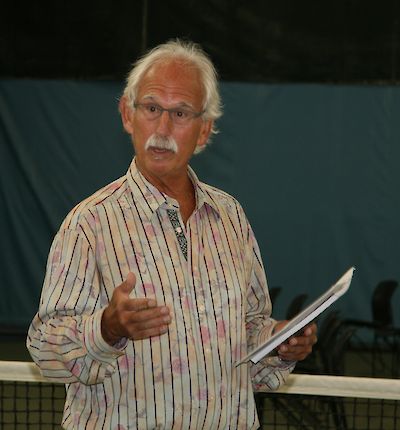When confronted with a losing pattern of play, nearly all competitive tennis players understand that they need to make a change. The point of this short piece is to illustrate that this change must always be undertaken with a strategic foundation and not simply be a different look meant to confuse the opposition. Merely changing the look can have an effect if and only if your opposition is fooled by appearances (as opposed to substance). See example #2 below to illustrate a change in look which does not have a strategic foundation, and hence, is flawed.
Proposition 1: IN ORDER TO BEAT A 3.5/4.5 TEAM YOU NEED TO GET THE 3.5 WOMAN TO MISS RETURNS OF SERVE. IF SHE CAN CONSISTENTLY GET THE BALL IN PLAY THEN YOUR JOB WILL BECOME MUCH MORE DIFFICULT.
A change in look can help to accomplish this. Forward movement on the part of the net player at the moment that he/she hears the server make contact can often be enough to make the 3.5 miss the return because she will start peeking at the net player. Once her ball watching skills are cracked, her level will drop. This change in look is a mirage only – you are not changing your court position. (Mike Akker tried this at the last practice and I think he can vouch for its effects).
Proposition 2: THERE IS ALWAYS A WAY TO CHANGE THE PATTERN OF PLAY SO THAT IT WILL TILT MORE FAVORABLY TOWARDS YOU. In a fairly even match, this tilt may be enough to change the outcome of the match!
Proposition 2 is proven simply by understanding what I call the ‘universal weakness’. The ‘universal weakness’ is any backhand played at or above shoulder level from anywhere behind the ¾ court mark. With the exception of touring pros on the men’s circuit, no other level of player can play offense with this shot. This means that, if you are prepared to seize the initiative, you may construct points to change the match in your favor. It also means that you need a reliable lob and/or a reliable looping topspin groundstroke with which to force your opponent far behind the baseline.
There is one case when Proposition 2 will not hold. This is when your opponent(s) is (are) clearly a full level better than you are. Since this is rarely the case in USTA tennis (this is the purpose behind the rating system!), I will ignore this case going forward except to say that it’s (usually) fun to hang out with these players after the match so that you can learn something.
Here are two examples of change: the first being an appropriate adjustment; the second being a change for the sake of change itself.
Example #1: When the guy is serving, the opposing female partner is missing nearly every return. Her partner is playing in the traditional ‘hotseat’ position. She asks him to adjust his position so that they are both back - thereby taking pressure off of her to hit a strong shot. She makes the next 7 returns in a row leading to a break of serve. This illustrates the well known proposition: it’s hard to break if you don’t get the ball over the net. Asking your partner to play back is not a sign of weakness. In 8.0 mixed, I often begin the match asking my partner to play back when the guy is serving. Once I’ve seen the serve a few times, I then move her up into attacking position.
Example #2: A serve and volleyer (guy) with a good serve cannot execute his game because the returners are repeatedly lobbing the return successfully over his partner’s head. The adjustment which he makes is to bring his 3.5 woman back to the baseline (‘bet you can’t lob over her head now!’). In this position, he will be ‘frozen’ out of the game because a smart opponent will hit every ball to her. A 3.5 woman cannot win an 8.0 match by herself unless she is on top of the net! - Another well known proposition. She requests the following adjustment alternatives: 1) pull me back a few steps to make the lobbing window smaller (this is another mirage effect – the lobbers should continue to lob until proven otherwise – but, as we’ve seen, mirages can have a possible influence); or 2) you should serve and stay back looking to use a fh approach as a means of getting in with me.

